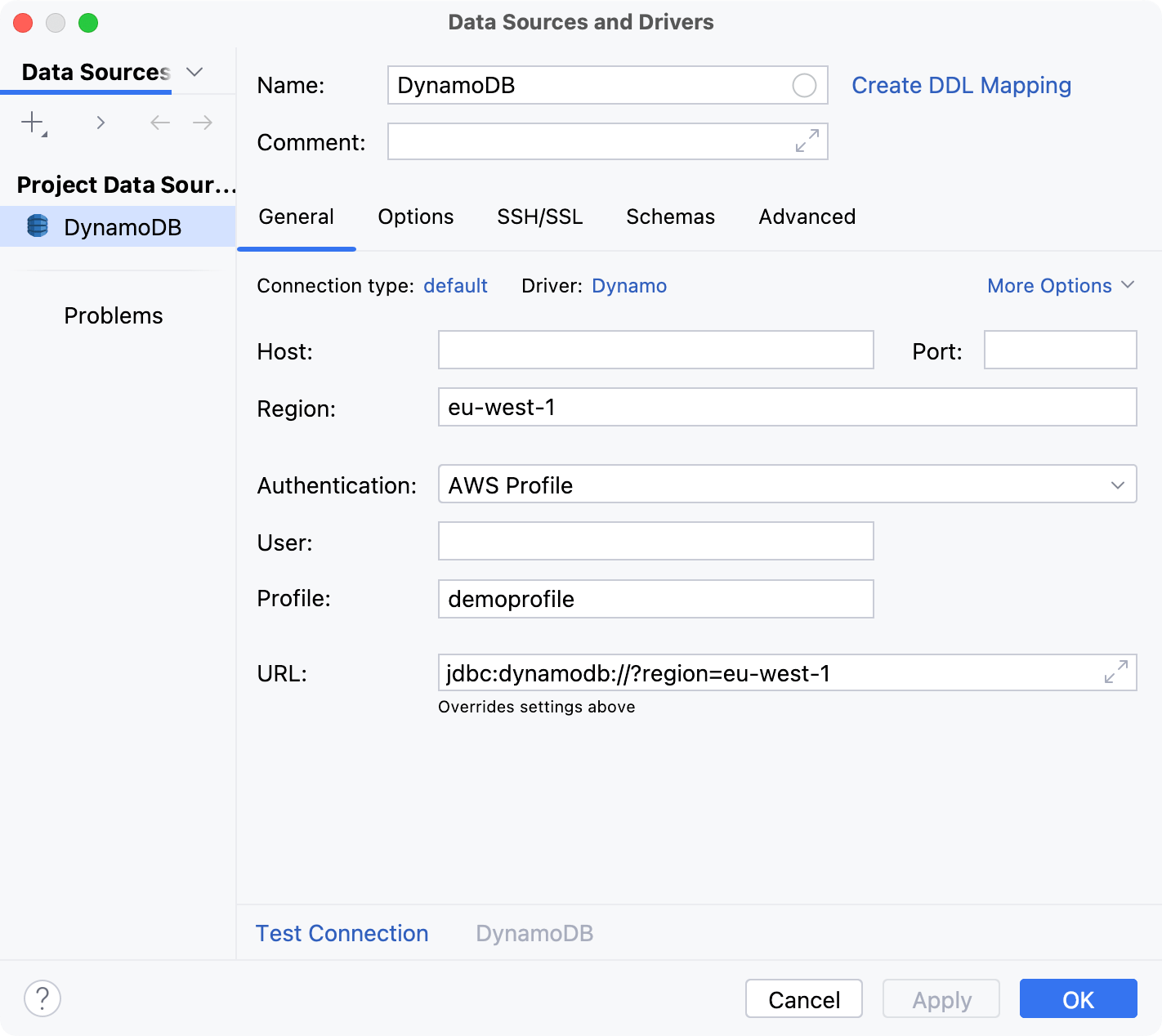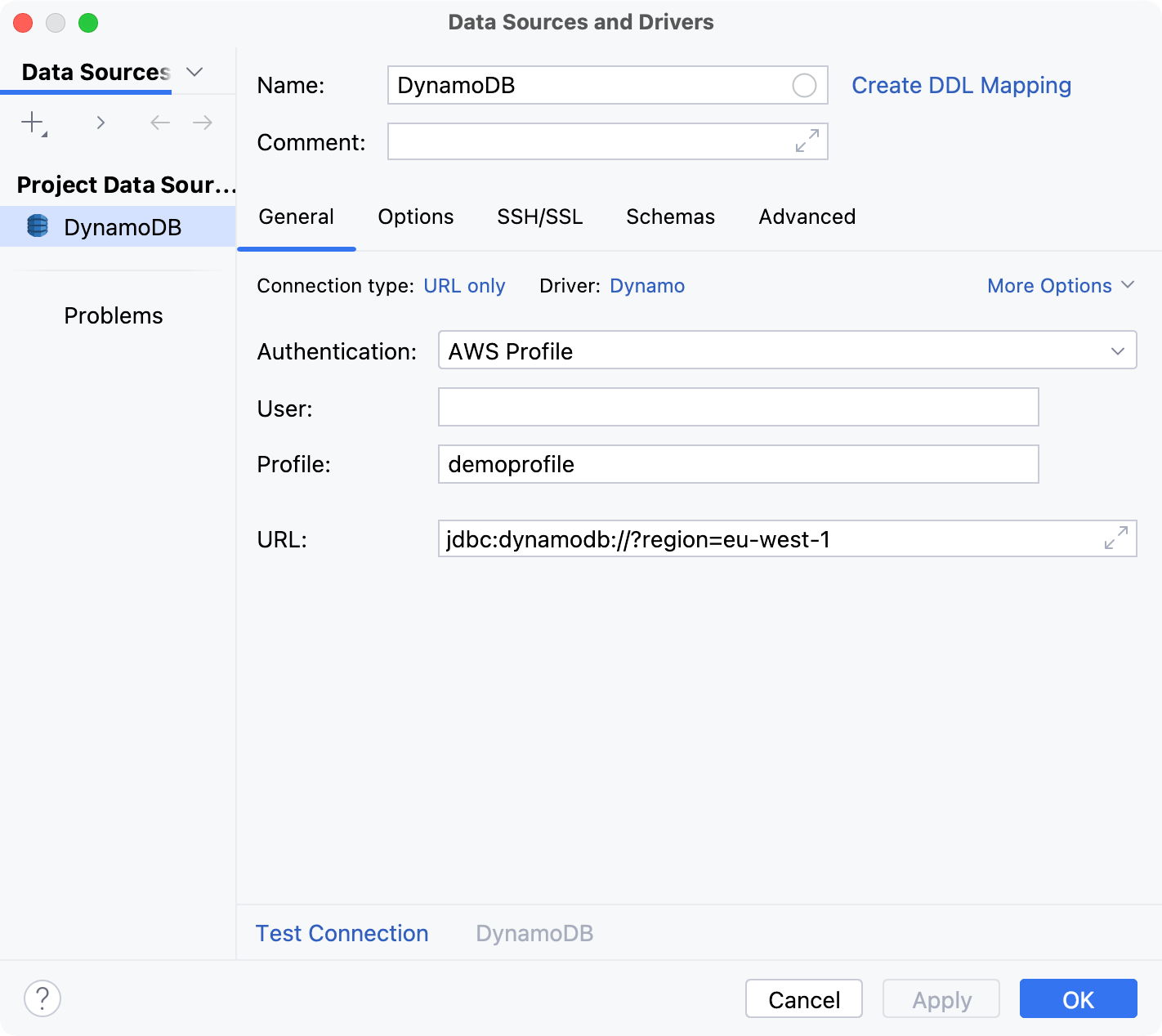Amazon DynamoDB
Enable the Database Tools and SQL plugin
This functionality relies on the Database Tools and SQL plugin, which is bundled and enabled in JetBrains Rider by default. If the relevant features are not available, make sure that you did not disable the plugin.
Press Ctrl+Alt+S to open settings and then select .
Open the Installed tab, find the Database Tools and SQL plugin, and select the checkbox next to the plugin name.
Official documentation and software
For full information about Amazon DynamoDB, refer to the official documentation.
To download Amazon DynamoDB database software, refer to the official software downloads.
Before you begin
This topic presents a general procedure on how you can create a data source for the connection to your Amazon DynamoDB database in JetBrains Rider, and run a test connection. It is assumed that you already have the necessary connection details and the database is up and running.
For example, if you want to run a database on your machine and connect to that database, the corresponding DBMS software must be installed on the machine first.
To learn about your DBMS software, refer to its official documentation.
Connect to an Amazon DynamoDB database
To connect to a database, create a data source that will store your connection details.
In the Database tool window, click
New and select Connect to Database.
If you have a connection string for the database defined in your solution or elsewhere, leave the Use connection string option selected and choose Amazon DynamoDB in the Database type selector.
Use the String selector to choose the desired connection string from your solution or type it in manually, then click Connect.
You can also choose Add data source manually, click Next and select Amazon DynamoDB in the Database source selector. Follow the wizard steps to form the connection string by configuring individual options.
To access all available options for the new database connection, click
in the Database window, then click
New and select Amazon DynamoDB.
In the General tab of Data Sources and Drivers dialog right pane, specify the driver and connection type.
In the Driver list, leave the default driver option, unless another driver is required for your connection.
From the Connection type list, select the connection type depending on the connection details that you have:
default: connect by using Host, Port, Region, and URL.
URL only: connect by using only the URL.
For the URL only connection type, the JDBC URL that you enter is used and as is, including the database credentials.
For the other connection types, the JDBC URL is broken down into connection details. You can either specify them separately and use the automatically generated URL, or you can enter the URL directly in the corresponding field.

Check if there is a Download missing driver files link at the bottom of the connection settings area. Click this link to download drivers that are required to interact with a database. For a direct download link, refer to the JetBrains JDBC drivers page.

Location for the downloaded JDBC drivers is the JetBrains Rider configuration directory.
You can also use your drivers for the database instead of the provided ones. For more information about connecting to a database with your driver, refer to Add a user driver to an existing connection.
If there is no Download missing driver files link, then you already have the required drivers.
Specify the database connection details. Alternatively, paste the JDBC URL in the URL field.
(Optional, local instance only) In the Host field, type your server address.
(Optional) In the Port field, type the port of Amazon DynamoDB.
In the Region field, enter the AWS Region of the database that you are connecting to.
From the Authentication dropdown, select the authentication method that you want to use to authenticate the connection. The following options are available:
AWS Profile: by using an AWS named profile in the Profile field.
For more information about AWS named profiles, refer to the DBMS-specific properties chapter.
No auth: authentication is not required.
In the Profile field, enter your named profile.
In the URL field, JetBrains Rider generates the JDBC URL automatically using the values of other connection settings.
If you need to use a JDBC URL with certain additional settings, paste it in the URL field.
Consider the following examples:
Local instance:
jdbc:dynamodb://localhost:8000.Named profile:
jdbc:dynamodb://.Named profile and redefined region:
jdbc:dynamodb://?region=eu-west-1.

From the Authentication dropdown, select the authentication method that you want to use to authenticate the connection. The following options are available:
AWS Profile: by using an AWS named profile in the Profile field.
For more information about AWS named profiles, refer to the DBMS-specific properties chapter.
No auth: authentication is not required.
In the Profile field, enter your named profile.
In the URL field, JetBrains Rider generates the JDBC URL automatically using the values of other connection settings.
If you need to use a JDBC URL with certain additional settings, paste it in the URL field.
Consider the following examples:
Local instance:
jdbc:dynamodb://localhost:8000.Named profile:
jdbc:dynamodb://.Named profile and redefined region:
jdbc:dynamodb://?region=eu-west-1.

For the reference information about connection settings and properties on the General and other tabs of Data Sources and Drivers dialog ( Shift+Enter) , see Connection settings and DBMS-specific properties.
Ensure that the database connection can be established using the provided details. To do this, click the Test Connection link at the bottom of the connection details section.

If you encounter any connection issues, refer to the Cannot connect to a database page.
(Optional) By default, only the default schema is introspected and available to work with. If you also want to work with other schemas, in the Schemas tab, select them for the introspection.

Click OK to create the data source.
Find your new data source in the Database tool window.
For more information about the Database tool window, see the corresponding reference topic.
For more information about working with database objects in JetBrains Rider, refer to Database objects.
To write and run queries, open the default query console by clicking the data source and pressing F4.
To view and edit data of a database object, open Data editor and viewer by double-clicking the object.
Connection settings and DBMS-specific properties
Connection settings
For the reference information about connection settings (for example, Host, Port, and so on) on the General and other tabs of Data Sources and Drivers dialog ( Shift+Enter) , see Data Sources.
DBMS-specific properties
General tab
Item | Description | Connection type |
|---|---|---|
Region | The AWS Region that is available for the Amazon DynamoDB. | default |
Profile | Your AWS named profile. A named profile is a collection of settings and credentials that you can use for authentication. Named profiles are stored in the Consider the following example of the
[default]
aws_access_key_id=ASIAIOSFODNN7EXAMPLE
aws_secret_access_key=wJalrXUtnFEMI/K7MDENG/bPxRfiCYEXAMPLEKEY
aws_session_token = IQoJb3JpZ2luX2IQoJb3JpZ2luX2IQoJb3JpZ2luX2IQoJb3JpZ2luX2IQoJb3JpZVERYLONGSTRINGEXAMPLE
[user1]
aws_access_key_id=ASIAI44QH8DHBEXAMPLE
aws_secret_access_key=je7MtGbClwBF/2Zp9Utk/h3yCo8nvbEXAMPLEKEY
aws_session_token = fcZib3JpZ2luX2IQoJb3JpZ2luX2IQoJb3JpZ2luX2IQoJb3JpZ2luX2IQoJb3JpZVERYLONGSTRINGEXAMPLE
To use the credentials stored in the For more information about named profiles, refer to the Amazon AWS official documentation. | all types (AWS Profile authentication method) |